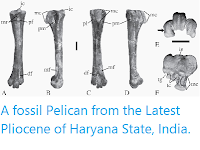A pair of White Storks, Ciconia ciconia, are raising a clutch of chicks in West Sussex, England, the first confirmed breeding pair in the British Isles since 1416, when a pair raised a clutch on the roof of St Giles Cathedral in Edinburgh. The Birds are one of three pairs that built nests on the Knepp Castle Estate this year, and form part of a cohort of over 100 Storks released at three sites in southern England by the White Stork Project, following the establishment of a successful captive breeding program at the Cotswold Wildlife Park in Oxfordshire.
A White Stork with a chick on a nest in West Sussex, England, where the birds have bred this year for the first time in six centuries. Manchester Metropolitan University.
Although not considered to be at risk internationally, White Storks disappeared from many parts of Europe between the Late Middle ages and early nineteenth century, due to changes in agricultural practices and draining of wetlands. The species is migratory, overwintering in Sub-Saharan Africa, and South Asia and breeding in the northern hemisphere summer in Europe, North Africa, and central Asia. The Birds do not cross the waters of the Mediterranean, but either circumnavigate the sea, passing through the Middle East into Eastern Europe, or across the Straights of Gibraltar into Western Europe. This effectively creates three separate populations of the Storks; one which overwinters in the Sahel Region of West Africa, and breeds in North Africa and Western Europe, one which overwinters in East and Southern Africa, and breeds in Eastern Europe and the Middle East, and one that overwinters in northwest India and Pakistan, and breeds in Kazakhstan.
The breeding grounds (green), overwintering sites (blue), and migratory routes of the White Stork, Ciconia ciconia. Wikimedia Commons.
See also...
Follow Sciency Thoughts on Facebook.








